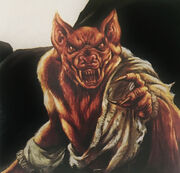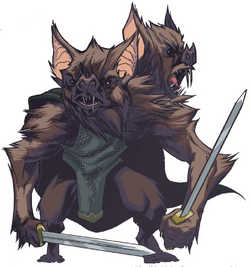Werebats were lycanthropes that required blood in order to survive. Most werebats came from goblin or drow stock, but they could be from other races.[3][2]
Description[]
A werebat's humanoid form was typically pug-nosed and sharp-toothed,[3][4] but even then the differences were so minute that they were virtually indistinguishable from non-afflicted individuals.[5] They could also transform into a giant bat.[3][4]
The most fearsome form of a werebat was their hybrid form, retaining a humanoid figure but with their arms extended into leathery wings, snouts pushed out from their face, and eyes that glowed when hit by light. Their teeth sharpened into fangs and their nails lengthened into pointed claws.[3][4]
Behavior[]

A depiction of a werebat from Spellfire: Master the Magic.
Werebats in normal form were normally elusive and quiet,[3] and despite not showing immediately distinguishable outer signs, those infected would start behaving more solitary and shy. Most were lonely and desperate, actively seeking out treasure and hoarding it in order to purchase a cure for their affliction.[5]
While just as intelligent as before, reports varied on whether their moral alignment was altered by the transformation. In some cases it was said that they were twisted into beings of evil, while in others they retained their same moral and ethical lens.[3][5] Most werebats preyed on humans, but even then the attacks were not malicious in nature. They merely viewed humans as lower on the food chain.[4]
Abilities[]
Not all werebats possessed the ability to change between all three forms, with some being restricted to becoming either a bat or a hybrid.[4] Werebats were capable of flight in both bat and hybrid forms,[3] although they could be heavy and clumsy when flying,[5] and could easily scale vertical surfaces.[3]
The act of biting temporarily revitalized the werebat with the consumption of blood, as their fangs were long and hollow and so able to drain the ichor from their prey.[3][5] The saliva of their fangs was also known to cause weakness similar to a ray of enfeeblement for several minutes. Those bitten by a werebat might become werebats themselves, with the chances increasing the more they were bitten,[4] although a cure disease or neutralize poison spell would stop the infection if applied within ninety minutes of contraction (six hours if a slow poison spell was used).[5]
Regardless of if they were underground, werebats still transformed at night like normal lycanthropes.[5] Some reports claimed that, like other lycanthropes, they could not be harmed by weapons that were not magical or silver, with the damage done being instantly reverted.[3] Others claimed that silver, holy water, and similar substances did nothing against them. Bat-influencing magic or controlling attempts by vampires did not work.[5]
Combat[]

Sina and Mesrak, an ettin werebat
When werebats fought, they were usually driven by bloodlust, and had set out to hunt alone in hybrid-form. They were nonetheless fully aware of what they were doing, and not acting as mindless beasts.[5] They shunned combat in their humanoid forms and routinely took advantage of their ability to fly when in battle.[4]
Society[]
Werebats lived in familial groups consisting of two parents and up to four children.[4] They were most commonly found in the Underdark and many were drow. Goblin werebats were shunned by other goblinoids because of their need for blood.[3][2]
Ecology[]
Even in their humanoid forms, werebats possessed oddly keen hearing and poor eyesight in the sun.[3][2] They had an acute sense of hearing, allowing them to use echolocation to sense the presence of things around them. This could be thwarted through the use of silencing magic. Werebats preferred to hide in dark areas like attics and caves that favored their nocturnal behavior. They resided in temperate climates within deserts, forests, or underground, in close proximity to ample supplies of prey.[3] Still, they rarely inhabited lairs as bats, using their humanoid habitations for shelter.[5]
Like all lycanthropes, there were "true" members of the race and the infected, with the former being born as werebats who couldn't be cured, and the latter having been infected with the werebat curse. Infected were far more dexterous than they were as their original race. Werebats born from a union between werebats and other races normally resulted in a normal racial variant, but could also create a curable child or a true werebat. Young werebats stayed in true bat form until the age of three before maturing into adults within the next year fully grown. They became extremely ravenous during this time and could devour numerous villagers before being sated.[4]
For every night spent without drinking at least a pint of blood, a werebat would grow increasingly tired, dying in just short of a week if starved of blood. Depending on how long they were starved, more blood was needed to recover with 6 pints needed to recover from the brink of death.[2] Although they could subsist on cattle and other animals without passing on the curse, they preferred that of humanoids.[4]
Werebats also possessed a natural affinity with regular bats.[4] Particular strains of werebat lycanthropy allowed the subject to summon and direct swarms of the creatures.[6] In cases, dozens to hundreds of normal bats and up to ten giant bats were present in their lairs, all at the command of the adults.[4]
History[]
In 1368 DR, a nobleman from Faerûn named Doljust displeased the goddess of ill-luck - Beshaba. The spiteful deity used her divine magics to affect the man's luck. Beshaba watched Doljust as he faced off against a werebat. The creature's cave has two dead toddlers in front of it, which was a grim omen of things to come. The goddess swayed the noble's hound, forcing the beast to pounce at the lycanthrope as Doljust swung his sword. As the man mourned his beloved dying dog, Beshaba's plan became apparent. Doljust swung his blade at a sound that came from behind. A moment later, another, smaller werebat, cleaved by Doljust's sword, shifted back to its humanoid form. The adolescent werebeast was a young child who whispered "grandfather" as he died in his older relative's arms.[7]
Notable Werebats[]
- Thelossa, a wandering drow druid
- Heskret, a male werebat from the High Forest
- Sina and Mesrak, an ettin werebat.
Appendix[]
Appearances[]
- Adventures
- Waterdeep: Dungeon of the Mad Mage
- Novels
- Tymora's Luck • Son of Thunder • The Black Bouquet
- Card Games
- AD&D Trading Cards • Spellfire: Master the Magic
References[]
- ↑ 1.0 1.1 Ed Greenwood (October 1984). “Bats that do more than bite”. In Kim Mohan ed. Dragon #90 (TSR, Inc.), pp. 20–23.
- ↑ 2.0 2.1 2.2 2.3 2.4 Christopher Perkins (November 2018). Waterdeep: Dungeon of the Mad Mage. Edited by Jeremy Crawford. (Wizards of the Coast), p. 317. ISBN 978-0-7869-6626-4.
- ↑ 3.00 3.01 3.02 3.03 3.04 3.05 3.06 3.07 3.08 3.09 3.10 3.11 3.12 3.13 James Wyatt, Rob Heinsoo (February 2001). Monster Compendium: Monsters of Faerûn. Edited by Duane Maxwell. (Wizards of the Coast), p. 30. ISBN 0-7869-1832-2.
- ↑ 4.00 4.01 4.02 4.03 4.04 4.05 4.06 4.07 4.08 4.09 4.10 4.11 4.12 4.13 Doug Stewart (June 1993). Monstrous Manual. (TSR, Inc). ISBN 1-5607-6619-0.
- ↑ 5.00 5.01 5.02 5.03 5.04 5.05 5.06 5.07 5.08 5.09 5.10 Ed Greenwood (July 1991). The Drow of the Underdark. (TSR, Inc), pp. 113–114. ISBN 1-56076-132-6.
- ↑ Jason Nelson-Brown (August 2006). “Man Forever”. Dungeon #137 (Paizo Publishing, LLC) (137)., p. 78.
- ↑ Kate Novak, Jeff Grubb (December 1997). Tymora's Luck. (TSR, Inc.), chap. 1, pp. 9–10. ISBN 0-7869-0726-6.
Connections[]
Magical bats: Deep bat (Azmyth • Night hunter • Sinister)
Planar bats: Shadowhunter bat
Humanoids: Bainligor • Desmodu
Lycanthropes: Werebat
Outsiders: Fire bat • Bat-people • Varrangoin
Undead bats: Bonebat
Related Creatures
Aranea • Coyotlwere • Hengeyokai • Jackalwere • Quasilycanthrope • Selkie • Shifter • Wolfwere
